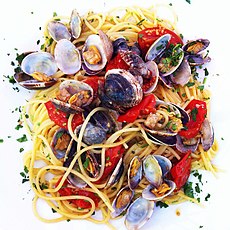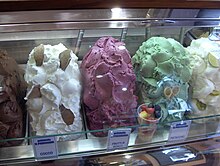Gelato: Difference between revisions
wrong |
|||
| Line 41: | Line 41: | ||
*[[Semifreddo]], a class of semi-frozen desserts. |
*[[Semifreddo]], a class of semi-frozen desserts. |
||
*[[Sorbet]] |
*[[Sorbet]] |
||
*[[Spaghettieis]], the German style of frozen dessert made to look like a dish of spaghetti, |
*[[Spaghettieis]], the German style of frozen dessert made to look like a dish of spaghetti, made with gelato |
||
*[[Granita]], a semi-frozen dessert made from sugar, water and various flavorings. |
*[[Granita]], a semi-frozen dessert made from sugar, water and various flavorings. |
||
*[[Frozen yogurt]], the cultured, frozen milk product, with a tart flavor |
*[[Frozen yogurt]], the cultured, frozen milk product, with a tart flavor |
||
Revision as of 11:50, 24 May 2013
This article needs additional citations for verification. (November 2009) |
 | |
| Type | Ice cream |
|---|---|
| Place of origin | Italy |
| Serving temperature | Cold |
| Main ingredients | Milk, cream, sugar, flavoring ingredient (e.g. – fruit or nut puree) |
 |
| Italian cuisine |
|---|
|
|
Gelato (Italian pronunciation: [dʒeˈlaːto]; plural: gelati) is the Italian word for ice cream, derived from the Latin word "gelātus." (meaning frozen). Gelato is made with milk, cream, various sugars, and flavoring such as fresh fruit and nut purees.[1]
Gelato is defined in English as a soft ice cream containing little or no air.[2] The ambiguity in use of the word in the United States stems from the fact that there is no standard of identity for gelato set forth by the US Department of Agriculture, as there is for ice cream.[3] Whereas ice cream in the US is defined by the Federal Code both by its ingredients, which includes milk fat (also known as butterfat) of 10% or more, gelato in the US covers a wide range of products including frozen desserts eaten like ice cream; products that are identical to ice cream with the exception of their butterfat contents; and premium ice cream containing butterfat far exceeding the minimums set forth in Italy. Depending on the recipe and the person making it, dairy-based gelato contains 16–24% sugar. Most ice cream in the United States contains 12 to 16% sugar. The sugar content in homemade gelato, as in traditional ice cream, is balanced with the water content to act as an anti-freeze to prevent it from freezing solid. Types of sugar used include sucrose, dextrose, and inverted sugar to control apparent sweetness. Typically, gelato—like any other ice cream—needs a stabilizing base. Egg yolks are used in yellow custard-based gelato flavors, including zabaione and creme caramel, and non-fat milk solids are also added to gelato to stabilize the base. Starches and gums, especially corn starch, are sometimes also used to thicken and stabilize the mix.
By statute, gelato in Italy must have at least 3.5% butterfat, with no upper limit established.
History
The history of gelato dates back to frozen desserts in ancient Rome and Egypt made from snow and ice brought down from mountaintops and preserved below ground. Later, frozen desserts appeared during banquets at the Medici court in Florence. In fact, the Florentine architect Bernardo Buontalenti is said to have invented modern ice cream in 1565, as he presented his recipe and his innovative refrigerating techniques to Catherine de' Medici. She in turn brought the novelty to France, where in 1686 the Sicilian fisherman Francesco Procopio dei Coltelli perfected the first ice cream machine.[4] The popularity of gelato among larger shares of the population, however, only increased in the 1920s–1930s in the northern Italian city of Varese, where the first gelato cart was developed. Italy is the only country where the market share of handmade gelato versus industrial one is over 55%.[5][6] Currently, over 5,000 Italian gelaterie, or gelato shops, all over the world occupy more than 15,000 gelatai, or gelato vendors.[7]
Production

Making gelato is similar to making ice cream. The mixture for gelato is typically prepared using a hot process first, where the sugars need to dissolve. White base is heated to 85 °C (185 °F) completing a pasteurization program. The hot process to make chocolate gelato is essentially the same for conventional ice cream, and depending on recipes, it is meant to be traditionally flavored with cocoa powder and cocoa butter.
See also
- Stracciatella
- Frozen custard, a frozen dessert made with cream and eggs
- Italian ice, a frozen dessert made from either concentrated syrup flavoring or fruit purees.
- Ice cream
- Semifreddo, a class of semi-frozen desserts.
- Sorbet
- Spaghettieis, the German style of frozen dessert made to look like a dish of spaghetti, made with gelato
- Granita, a semi-frozen dessert made from sugar, water and various flavorings.
- Frozen yogurt, the cultured, frozen milk product, with a tart flavor
- Gelato University
References
- ^ "What Is Gelato?". wiseGeek. Retrieved 16 May 2012.
- ^ "Gelato - Definition and More from the Free Merriam-Webster Dictionary". Merriam-webster.com. Retrieved 2012-09-10.
- ^ "CFR - Code of Federal Regulations Title 21". Accessdata.fda.gov. Retrieved 2012-09-10.
- ^ Storia del gelato. Interfred.it. Retrieved on 2012-07-06.
- ^ See italiangelato.info
- ^ See gelatoartigianale.it
- ^ See guide.supereva.it, outside of Italy the bigger number of gelaterie is located in UK, France, Germany and north Europe in general.
